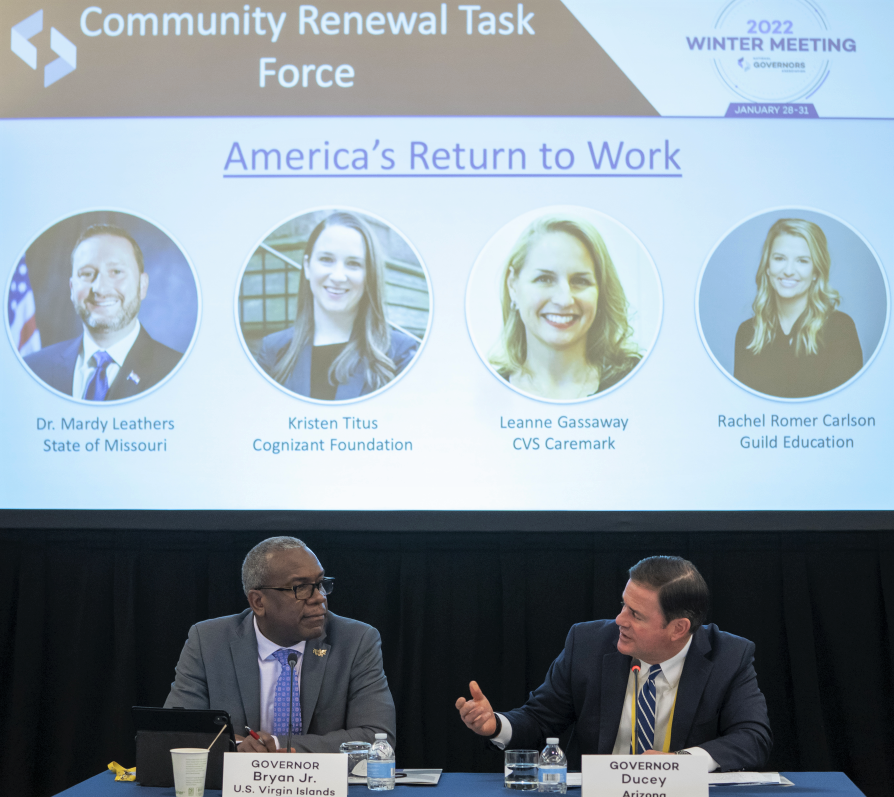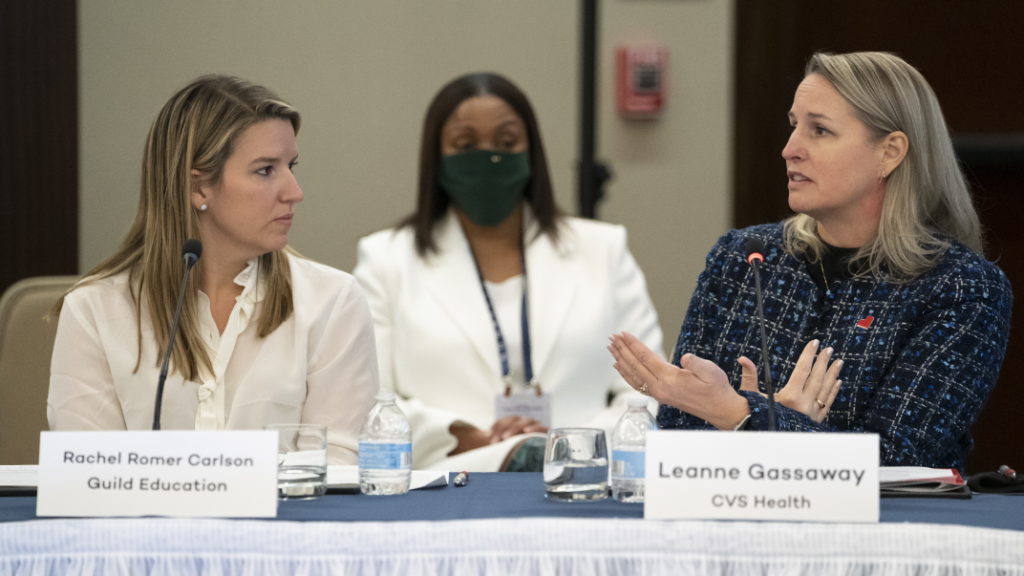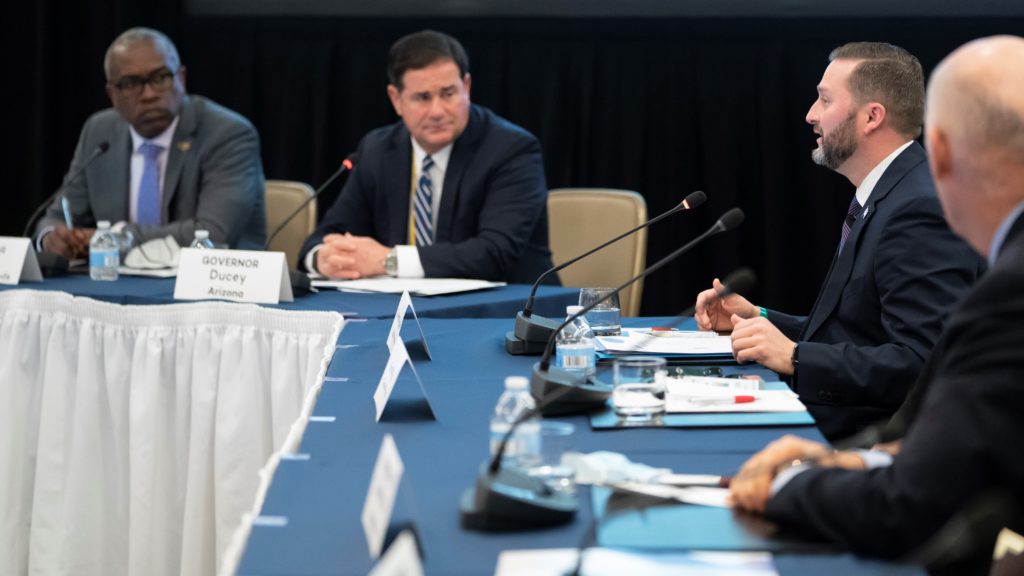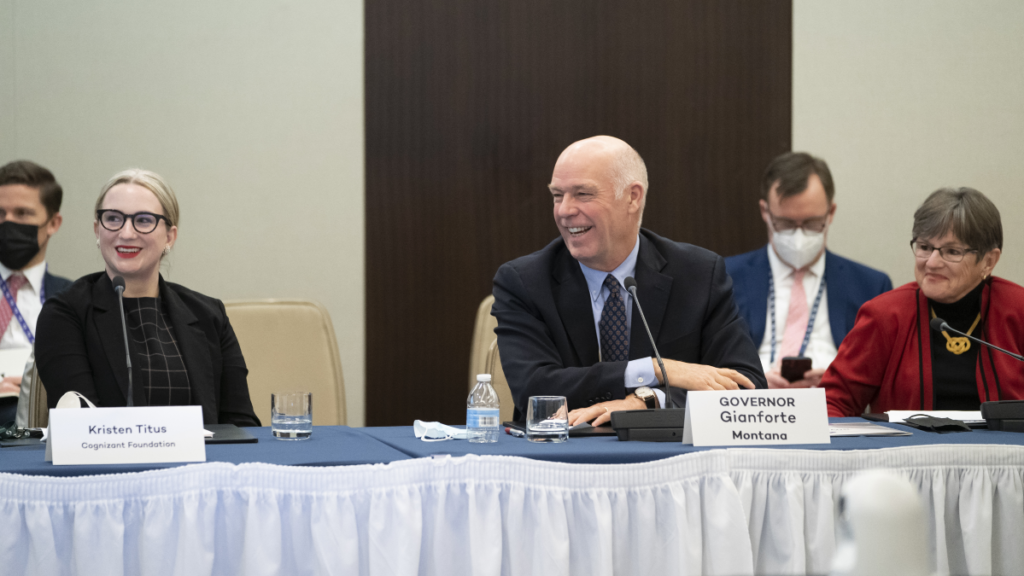A look at the Community Renewal Task Force discussion on getting people back to work, reducing disparities in the workforce, and leveraging federal investments to maximize opportunities to upskill workers and meet the needs of businesses and communities alike.
By Tim Carlton and Rachael Stephens
During the National Governors Association 2022 Winter Meeting, NGA’s Community Renewal Task Force—a bipartisan committee of Governors focused on a range of issues including workforce development, education, agriculture, broadband and criminal justice— convened with business and workforce development leaders to discuss the historic impacts of the COVID-19 pandemic on America’s workforce and ways to strengthen the economy going forward.

Leading the discussion was Community Renewal Co-Chair Governor Albert Bryan of the U.S. Virgin Islands and Governor Doug Ducey of Arizona. Gov. Duceyfilled in for taskforce Co-Chair Governor Mike Parson of Missouri, who was unable to attend the NGA Winter Meeting. Joining Governors Bryan and Ducey were Mardy Leathers, director of Missouri’s Office of Workforce Development; Kristen Titus, executive director of the Cognizant Foundation; Leanne Gassaway, vice president of State Government Affairs at CVS Health; and Rachel Romer Carlson, co-founder and CEO of Guild Education.
Gov. Bryan kicked off the discussion by emphasizing that getting Americans back to work should not be simply about getting a job. “We want to make sure that when we get these jobs, that they’re good paying jobs” and that workers can “grow within their organizations…have access to affordable health care [and] childcare…and provide opportunities for all workers regardless of race, gender, or any other thing.” These sentiments were echoed by Governors as well as the business and workforce leaders throughout the discussion.
Gov. Ducey pointed out that progress has been made in recovery, yet there is still a long way to go. “In Arizona, we’ve officially recovered all of the jobs since the start of the pandemic…and our unemployment rate is the lowest it’s been since before the Great Recession,” he said. However, “Across the country we have over 10 million job openings that need to be filled despite the fact that there are only 6 million people officially counted as unemployed. Clearly there is a demand for workers that is not being met.”

Speaking about the role CVS Health has played in getting Americans back to work, Leanne Gassaway shared that CVS didn’t close a single store during the pandemic, due to the company’s focus on getting people to work and keeping people at work. To do this, CVS provided employees with PPE and other equipment necessary to keep employees safe, in addition to providing bonuses and boosting minimum wages to $15 per hour.
Ms. Gassaway also highlighted CVS’s role in ensuring communities were able to remain healthy and safe as they returned to work, including administering over 41 million COVID tests and 51 million vaccines. Without companies like CVS Health, who since the start of the pandemic have partnered with local communities, states and territories, and the federal government to ensure American workers can access COVID testing and vaccination, America’s return to work would have been much harder—a fact to which any Governor or state workforce agency can attest.
As an example, Mardy Leathers of Missouri shared a reality that resonates across the country: “[During] the first week of March 2020, we had about 23,000 people in Missouri accessing UI benefits. By the first week in April, we were at 887,000.” Now, less than two years later, Missouri is well on the road to recovery. Mr. Leathers pointed out, “We’ve now restaffed…all but 38,000 jobs we lost during the pandemic. We’re at 3.3% unemployment and our labor force participation rate continues to rise.”

Mr. Leathers highlighted the positive impact Missouri’s participation in the NGA Workforce Innovation Network (WIN) has had on their recovery. “For us, it really was transformational,” he said. NGA WIN “allowed us to pull ourselves out from the firefighting mode and begin to think about actually moving forward with recovery.”
NGA WIN, which to date has engaged 15 states and over 20 corporate, philanthropic, subject-matter expert, and practitioner partners, is helping states build capacity for near-term innovation while developing a long-term strategy to improve state workforce systems and outcomes.
A key partner in NGA WIN, Kristen Titus and the Cognizant Foundation focus on how to prepare communities for the jobs of today and tomorrow by drilling down on three things: talent pipelines, pathways and systems change. As pipelines and pathways are built for technology jobs—which she noted were the fastest-growing and highest-paying jobs available today—Ms. Titus underscored the importance of systems change to remove barriers and align policies to unlock resources and services that people need as they navigate the workforce system.

Task Force Governors reaffirmed the importance of these types of resources and services. Governor Tony Evers of Wisconsin described the challenge his state is facing in “connecting the dots” between job seekers and work supports such as childcare or transit. Governors Laura Kelly of Kansas and Tom Wolf of Pennsylvania also emphasized that supports like childcare are key to labor force participation and are needs their states are actively working to address, including through public-private partnerships. Montana Governor Greg Gianforte commended Cognizant’s innovative partnerships with area tribes and the University of Montana to engage and train Montanans for the jobs the company is bringing to the state.
Driving home the impact that successful partnerships can have, Rachel Romer Carlson shared a video of a woman named Iris, who through Guild Education’s partnership with Chipotle, used Chipotle’s education benefits to go from working in their kitchen to attaining a bachelor’s degree in human resources and a role as a Chipotle recruiter, making more than $100,000 per year.
According to Ms. Romer Carlson, Iris “is one of millions of Americans—88 million we think—who need to go back to school in order to have a chance at a middle-class life.” Despite this need, Ms. Romer Carlson agreed that “pathways are not being nurtured today.”
That is why Guild is partnering with a number of large employers to help them offer career pathways and better-designed education benefits as part of an employee’s value proposition.
The benefit to employers is that, according to Ms. Romer Carlson, workers who participate in employer-supported educational programs are retained at a rate twice that of their peers, and they are being promoted within their company at 7.5 times the rate of their peers. Colorado Governor Jared Polis pointed out that state governments may also benefit from implementing similar types of programs as they, like many private sector employers, work to better attract and retain talent.
This discussion highlighted the power of public-private and multi-agency partnerships, driven by Governors’ leadership, to move beyond the status quo and reshape a workforce system that better serves the needs of both workers and employers. Moreover, it reaffirmed and built upon Governors’ Principles to Renew the Federal Workforce System, which were developed under the leadership of Community Renewal Task Force Governors and ratified by NGA’s membership in July 2021.












